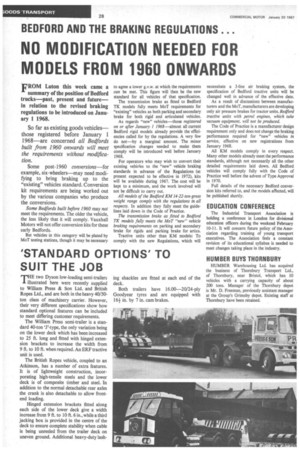NO MODIFICATION NEEDED FOR MODELS FROM 1960 ONWARDS
Page 30

If you've noticed an error in this article please click here to report it so we can fix it.
ROM Luton this week came a summary of the position of Bedford trucks—past, present and future— in relation to the revised braking regulations to be introduced on January 11968.
So far as existing goods vehicles— those registered before January 1 1968—are concerned all Bedfords built from 1960 onwards will meet the requirements without modifica tion.
Some post-1960 conversions—for example, six-wheelers—may need modifying to bring braking up to the "existing" vehicles standard. Conversion kit requirements are being worked out by the various companies who produce the conversions.
Some Bedfords built before 1960 may not meet the requirements. The older the vehicle, the less likely that it will comply. Vauxhall Motors will not offer conversion kits for these early Bedfords.
But vehicles in this category will be plated by MoT testing stations, though it may be necessary
to agree a lower g.v.w. at which the requirements can be met. This figure will then be the new standard for all vehicles of that specification.
The transmission brake as fitted to Bedford TK models fully meets MoT requirements for "existing" vehicles as both parking and secondary brake for both rigid and articulated vehicles.
As regards "new" vehicles—those registered on or after January 1 1968—almost all current Bedford rigid models already provide the efficiencies called for by the regulations. A very few do not—by a marginal amount. The minor specification changes needed to make them comply will be introduced well before January 1968.
For operators who may wish to convert their existing vehicles to the "new" vehicle braking standards in advance of the Regulations (at present expected to be effective in 1972), kits will be available during 1967. The cost will be kept to a minimum, and the work involved will not be difficult to carry out.
All models of the Bedford KM 14-22-ton-gross weight range comply with the regulations in all respects. In addition they fully meet the guidelines laid down in the Code of Practice.
The transmission brake as fitted to Bedford 77C models fully meets the MoT "new" vehicle braking requirements on parking and secondary brake for rigids and parking brake for artics.
Tractive units other than KM models: To comply with the new Regulations, which will necessitate a 3-line air braking system, the specification of Bedford tractive units will be changed well in advance of the effective date.
As a result of discussions between manufacturers and the MoT, manufacturers are developing only air pressure brakes for tractor units. Bedford tractive units with petrol engines, which take vacuum equipment, will not be produced.
The Code of Practice is a manufacturer design requirement only and does not change the braking performance required for "new" vehicles in service, effective on new registrations from January 1968.
All KM models comply in every respect. Many other models already meet the performance standards, although not necessarily all the other detailed requirements laid down. All Bedford vehicles will comply fully with the Code of Practice well before the advent of Type Approval in 1970.
Full details of the necessary Bedford conversion kits referred to, and the models affected, will be published shortly.




























































































































